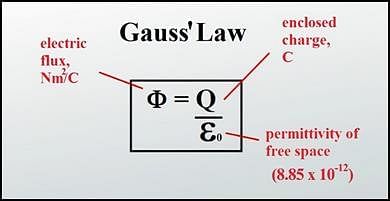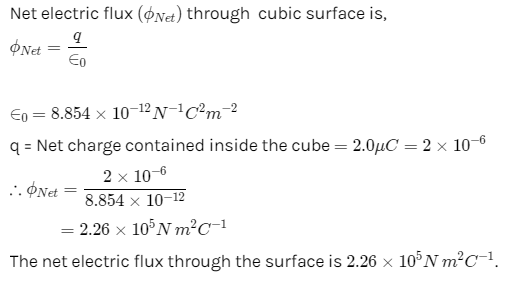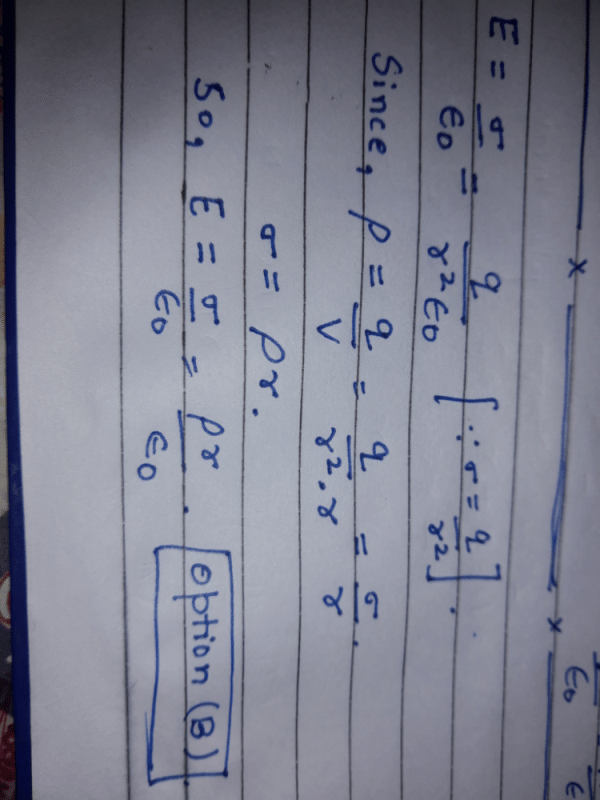All questions of Electric Charge for Grade 9 Exam
Three concentric metallic spherical shells of radii R, 2R, 3R, are given charges Q1, Q2, Q3, respectively. It is found that the surface charge densities on the outer surfaces of the shells are equal. Then, the ratio of the charges given to the shells, Q1: Q2: Q3, is - a)it is 1:03:05
- b)it is 1:02:03
- c)it is 1:04:09
- d)it is 1:08:18
Correct answer is 'A'. Can you explain this answer?
Three concentric metallic spherical shells of radii R, 2R, 3R, are given charges Q1, Q2, Q3, respectively. It is found that the surface charge densities on the outer surfaces of the shells are equal. Then, the ratio of the charges given to the shells, Q1: Q2: Q3, is
a)
it is 1:03:05
b)
it is 1:02:03
c)
it is 1:04:09
d)
it is 1:08:18
|
|
Sanaya Kumar answered |
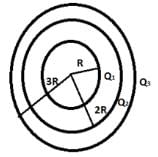
Since the charge goes to outer surface when given inside so the charges on concentri shells are respectively.
Q1, Q1 + Q2, Q1 + Q2 + Q3. Sine their charge densities are equal so σ1 = σ2 = σ3

So Q1 = 3Q2 = 5Q3 so 1 : 3 : 5
The linear charge densities of two infinitely long thin and parallel wires are 4Cm−1, 8Cm−1 and separation between them is 4 cm. Then the electric field intensity at mid point on the line joining them is- a)18 × 1011 NC−1
- b)36 × 1011NC−1
- c)9 × 1011NC−1
- d)72 × 1011 NC−1
Correct answer is option 'B'. Can you explain this answer?
The linear charge densities of two infinitely long thin and parallel wires are 4Cm−1, 8Cm−1 and separation between them is 4 cm. Then the electric field intensity at mid point on the line joining them is
a)
18 × 1011 NC−1
b)
36 × 1011NC−1
c)
9 × 1011NC−1
d)
72 × 1011 NC−1
|
|
Ashutosh Malik answered |
Given Data
- Linear charge density of wire 1 (λ1) = 4 C/m
- Linear charge density of wire 2 (λ2) = 8 C/m
- Separation between wires (d) = 4 cm = 0.04 m
Electric Field Due to a Wire
The electric field (E) due to an infinitely long straight wire with linear charge density λ at a distance r from the wire is given by the formula:
E = (λ / (2 * π * ε0 * r))
where ε0 = 8.85 × 10^-12 C^2/(N·m^2) is the permittivity of free space.
Midpoint Calculation
- The distance from each wire to the midpoint (r) = d/2 = 0.02 m
Electric Fields Calculation
1. Electric Field from Wire 1 (E1)
E1 = (λ1 / (2 * π * ε0 * r))
= (4 / (2 * π * 8.85 × 10^-12 * 0.02))
2. Electric Field from Wire 2 (E2)
E2 = (λ2 / (2 * π * ε0 * r))
= (8 / (2 * π * 8.85 × 10^-12 * 0.02))
Direction of Electric Fields
- E1 points away from wire 1 (to the right).
- E2 points away from wire 2 (to the left).
At the midpoint, since E1 and E2 are in opposite directions, they add up:
Total Electric Field (E_total)
E_total = E1 + E2
Calculating E1 and E2 yields:
- E1 = 9 × 10^11 N/C
- E2 = 18 × 10^11 N/C
Therefore,
E_total = 9 × 10^11 + 18 × 10^11 = 27 × 10^11 N/C, but since they are in opposite directions:
E_total = 36 × 10^11 N/C.
Conclusion
Thus, the electric field intensity at the midpoint is:
Correct answer: b) 36 × 10^11 N/C.
- Linear charge density of wire 1 (λ1) = 4 C/m
- Linear charge density of wire 2 (λ2) = 8 C/m
- Separation between wires (d) = 4 cm = 0.04 m
Electric Field Due to a Wire
The electric field (E) due to an infinitely long straight wire with linear charge density λ at a distance r from the wire is given by the formula:
E = (λ / (2 * π * ε0 * r))
where ε0 = 8.85 × 10^-12 C^2/(N·m^2) is the permittivity of free space.
Midpoint Calculation
- The distance from each wire to the midpoint (r) = d/2 = 0.02 m
Electric Fields Calculation
1. Electric Field from Wire 1 (E1)
E1 = (λ1 / (2 * π * ε0 * r))
= (4 / (2 * π * 8.85 × 10^-12 * 0.02))
2. Electric Field from Wire 2 (E2)
E2 = (λ2 / (2 * π * ε0 * r))
= (8 / (2 * π * 8.85 × 10^-12 * 0.02))
Direction of Electric Fields
- E1 points away from wire 1 (to the right).
- E2 points away from wire 2 (to the left).
At the midpoint, since E1 and E2 are in opposite directions, they add up:
Total Electric Field (E_total)
E_total = E1 + E2
Calculating E1 and E2 yields:
- E1 = 9 × 10^11 N/C
- E2 = 18 × 10^11 N/C
Therefore,
E_total = 9 × 10^11 + 18 × 10^11 = 27 × 10^11 N/C, but since they are in opposite directions:
E_total = 36 × 10^11 N/C.
Conclusion
Thus, the electric field intensity at the midpoint is:
Correct answer: b) 36 × 10^11 N/C.
When a negatively charged conductor is connected to earth,
- a)No charge flow occurs.
- b)Protons flow from the conductor to the earth.
- c)Electrons flow from the earth to the conductor.
- d)Electrons flow from the conductor to the earth.
Correct answer is option 'D'. Can you explain this answer?
When a negatively charged conductor is connected to earth,
a)
No charge flow occurs.
b)
Protons flow from the conductor to the earth.
c)
Electrons flow from the earth to the conductor.
d)
Electrons flow from the conductor to the earth.
|
|
Riya Banerjee answered |
Explanation:
When a negatively charged conductor is connected to the earth, electrons will flow from the conductor to the earth. This is because electrons have a negative charge and they will be repelled from the negatively charged conductor and attracted to the positively charged earth. As electrons flow from the conductor to the earth, the negative charge on the conductor will gradually decrease until it becomes neutral.
- Option A is incorrect because charge flow does occur when a negatively charged conductor is connected to the earth.
- Option B is incorrect because protons have a positive charge and they are not free to move in a conductor.
- Option C is incorrect because electrons flow from the earth to the conductor, not the other way around.
Two insulated charged copper spheres A and B have their centres separated by a distance of 50 cm. What is the mutual force of electrostatic repulsion if the charge on each is 6.5×10−7C ? The radii of A and B are negligible compared to the distance of separation.- a)4.5×10−2N
- b)2.5×10−2N
- c)1.5×10−2N
- d)3.5×10−2N
Correct answer is option 'C'. Can you explain this answer?
Two insulated charged copper spheres A and B have their centres separated by a distance of 50 cm. What is the mutual force of electrostatic repulsion if the charge on each is 6.5×10−7C ? The radii of A and B are negligible compared to the distance of separation.
a)
4.5×10−2N
b)
2.5×10−2N
c)
1.5×10−2N
d)
3.5×10−2N

|
Kavya Das answered |

A point charge of 2.0 μCμC is at the centre of a cubic Gaussian surface 9.0 cm on edge. What is the net electric flux through the surface?- a)1.7×105Nm2/C
- b)2.1×105Nm2/C
- c)2.2×105Nm2/C
- d)1.9×105Nm2/C
Correct answer is option 'C'. Can you explain this answer?
A point charge of 2.0 μCμC is at the centre of a cubic Gaussian surface 9.0 cm on edge. What is the net electric flux through the surface?
a)
1.7×105Nm2/C
b)
2.1×105Nm2/C
c)
2.2×105Nm2/C
d)
1.9×105Nm2/C

|
Princy Goyal answered |
This question is based on Gauss law. Net electric flux will be 1/Enot times the total charge enclosed
Can you explain the answer of this question below:Electric field lines can be said to be
- A:
lines of equal Electric field
- B:
drawing lines of electric fields
- C:
lines of equal Electric voltage
- D:
graphical representation of electric fields.
The answer is d.
Electric field lines can be said to be
lines of equal Electric field
drawing lines of electric fields
lines of equal Electric voltage
graphical representation of electric fields.

|
P. Poonia answered |
Simple they are imaginary line which be represent by graphical manner
A point charge causes an electric flux of −1.0×103Nm2/C to pass through a spherical Gaussian surface of 10.0 cm radius centred on the charge. (a) If the radius of the Gaussian surface were doubled, how much flux would pass through the surface? (b) What is the value of the point charge? - a) 103Nm2/C,−7.8nC
- b) B 103Nm2/C,−8.8nC
- c) −103Nm2/C,−8.8nC
- d) −103Nm2/C,−6.8nC
Correct answer is option 'C'. Can you explain this answer?
A point charge causes an electric flux of −1.0×103Nm2/C to pass through a spherical Gaussian surface of 10.0 cm radius centred on the charge. (a) If the radius of the Gaussian surface were doubled, how much flux would pass through the surface? (b) What is the value of the point charge?
a)
103Nm2/C,−7.8nC
b)
B 103Nm2/C,−8.8nC
c)
−103Nm2/C,−8.8nC
d)
−103Nm2/C,−6.8nC
|
|
Mira Sharma answered |
A. Doubling the radius of Gaussian surface will not affect the electric flux since the charge enclosed is the same in both cases. Thus, the flux will remain the same i.e., –1.0 x 10^3 Nm^2/C
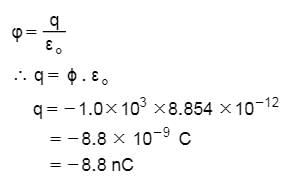
(b) Using gauss theorem,

If 109electrons move out of a body to another body every second, how much time is approximately required to get a total charge of 1 C on the other body?- a)120 years
- b)220 years
- c)200 years
- d)180 years
Correct answer is option 'C'. Can you explain this answer?
If 109electrons move out of a body to another body every second, how much time is approximately required to get a total charge of 1 C on the other body?
a)
120 years
b)
220 years
c)
200 years
d)
180 years
|
|
Naina Bansal answered |
we know that 1 Coulomb = 6.242�10^18 eletrons
given 10^9 electrons take 1 secs
=> 10^9 electrons ------> 1 sec
=> 1 electrons ---------> 1/(10^9) secs
=> 6.242�10^18 ------> 6.242�10^18/ (10^9)
= 6.242�10^9 secs = 6.242�10^9/ (60*60*24*365) years
=197.93 years
At any point on S on an electric field line - a)the perpendicular to the line is in the direction of at that point
- b)the tangent to the line is in the direction of at that point
- c)the binormal to the line is in the direction of at that point
- d)the curvature is in the direction of at that point
Correct answer is option 'B'. Can you explain this answer?
At any point on S on an electric field line
a)
the perpendicular to the line is in the direction of at that point
b)
the tangent to the line is in the direction of at that point
c)
the binormal to the line is in the direction of at that point
d)
the curvature is in the direction of at that point

|
Amar Pillai answered |
When a tangent is drawn at any point on field line then that tangent gives the direction of electric field at that point
Two equal positive charges q1 = q2 = 2.0 μC. μC are located at x = 0, y =0.3 and x =0 and y = -0.3 m respectively. What are the magnitude and direction of the total electric force (expressed in Newton and degrees counter clockwise w.r.t x - axis) that q1 and q2 exert on a third charge Q = 4.0 μC. μC at x =0.4 and y = 0 m- a)0.46,0.00
- b)0.44,2.00
- c)0.42,1.00
- d)0.48,3.00
Correct answer is option 'A'. Can you explain this answer?
Two equal positive charges q1 = q2 = 2.0 μC. μC are located at x = 0, y =0.3 and x =0 and y = -0.3 m respectively. What are the magnitude and direction of the total electric force (expressed in Newton and degrees counter clockwise w.r.t x - axis) that q1 and q2 exert on a third charge Q = 4.0 μC. μC at x =0.4 and y = 0 m
a)
0.46,0.00
b)
0.44,2.00
c)
0.42,1.00
d)
0.48,3.00
|
|
Ankita Datta answered |
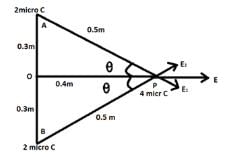
Side AP =  = 0.5m Electric Field due to charge at A on point P = Elecric Field due to charge at B on
= 0.5m Electric Field due to charge at A on point P = Elecric Field due to charge at B on 
 = 0.5m Electric Field due to charge at A on point P = Elecric Field due to charge at B on
= 0.5m Electric Field due to charge at A on point P = Elecric Field due to charge at B on 
point P 



Where  So force due to this field on charge P
So force due to this field on charge P
 So force due to this field on charge P
So force due to this field on charge PF = qE = 4 x 10-6 x 115.2 x 103 F = 0.46N
Since this force in the direction of positive x axis so angle = 00
Find the electric field inside the sphere which carries a charge density proportional to the distance from the origin
ρ = kr- a)ρ/ε0
- b)ρr/ε0
- c) ρr2/ε0
- d)none of the above
Correct answer is option 'B'. Can you explain this answer?
Find the electric field inside the sphere which carries a charge density proportional to the distance from the origin
ρ = kr
ρ = kr
a)
ρ/ε0
b)
ρr/ε0
c)
ρr2/ε0
d)
none of the above
|
|
Geetika Tiwari answered |
We can start by using Gauss's Law to find the electric field. Gauss's Law states that the flux of the electric field through any closed surface is proportional to the charge enclosed by the surface. Mathematically, it can be written as:
∮E⋅dA = Qenc/ε0
where E is the electric field, dA is an infinitesimal area element on the surface, Qenc is the charge enclosed by the surface, and ε0 is the permittivity of free space.
In this case, we can choose a spherical Gaussian surface centered at the origin, with radius r. The charge enclosed by this surface is:
Qenc = ∫ρdV
where ρ is the charge density and dV is an infinitesimal volume element. Since the charge density is proportional to the distance from the origin, we can write:
ρ = k r
where k is a constant of proportionality. The integral becomes:
Qenc = ∫ρdV = k ∫r^2sinθdrdθdφ
where the limits of integration are 0 to r for r, 0 to π for θ, and 0 to 2π for φ. Evaluating the integral gives:
Qenc = (4/3)πk r^3
Now we can apply Gauss's Law to find the electric field. The flux of the electric field through the Gaussian surface is:
∮E⋅dA = E(4πr^2)
where we have used the fact that the surface area of a sphere is 4πr^2. Therefore, Gauss's Law gives us:
E(4πr^2) = (4/3)πk r^3/ε0
Solving for E, we get:
E = k r/3ε0
Therefore, the electric field inside the sphere is proportional to the distance from the origin, with a constant of proportionality k/3ε0.
∮E⋅dA = Qenc/ε0
where E is the electric field, dA is an infinitesimal area element on the surface, Qenc is the charge enclosed by the surface, and ε0 is the permittivity of free space.
In this case, we can choose a spherical Gaussian surface centered at the origin, with radius r. The charge enclosed by this surface is:
Qenc = ∫ρdV
where ρ is the charge density and dV is an infinitesimal volume element. Since the charge density is proportional to the distance from the origin, we can write:
ρ = k r
where k is a constant of proportionality. The integral becomes:
Qenc = ∫ρdV = k ∫r^2sinθdrdθdφ
where the limits of integration are 0 to r for r, 0 to π for θ, and 0 to 2π for φ. Evaluating the integral gives:
Qenc = (4/3)πk r^3
Now we can apply Gauss's Law to find the electric field. The flux of the electric field through the Gaussian surface is:
∮E⋅dA = E(4πr^2)
where we have used the fact that the surface area of a sphere is 4πr^2. Therefore, Gauss's Law gives us:
E(4πr^2) = (4/3)πk r^3/ε0
Solving for E, we get:
E = k r/3ε0
Therefore, the electric field inside the sphere is proportional to the distance from the origin, with a constant of proportionality k/3ε0.
A tennis ball which has been covered with charges is suspended by a thread so that it hangs between two metal plates. One plate is earthed, while other is attracted to a high voltage generator. The ball- a)hangs without moving
- b)is attracted to the high voltage plate and stays there
- c)swings backward & forward hitting each plate in turn
- d)is repelled by earthed plate and stays there.
Correct answer is option 'C'. Can you explain this answer?
A tennis ball which has been covered with charges is suspended by a thread so that it hangs between two metal plates. One plate is earthed, while other is attracted to a high voltage generator. The ball
a)
hangs without moving
b)
is attracted to the high voltage plate and stays there
c)
swings backward & forward hitting each plate in turn
d)
is repelled by earthed plate and stays there.

|
Vaishnavi Dasgupta answered |
Explanation:The plate which connected to high voltage generator induces negative charge on ball which causes attraction. When the ball strikes the positive plate, charge distribution again takes place that is the bass becomes positive and repulsion takes place. When it strikes the plate which connected to earth than its charge goes to earth and again it will be attracted towards positive plate. Hence the ball swings backward and forward hitting each plate in turn.
Two point charges A and B, having charges +Q and –Q respectively, are placed at certain distance apart and force acting between them is F. If 25% charge of A is transferred to B, then force between the charges becomes- a)4F/3
- b)F
- c)9F/16
- d)16F/9
Correct answer is option 'C'. Can you explain this answer?
Two point charges A and B, having charges +Q and –Q respectively, are placed at certain distance apart and force acting between them is F. If 25% charge of A is transferred to B, then force between the charges becomes
a)
4F/3
b)
F
c)
9F/16
d)
16F/9

|
Ambition Institute answered |
In case I :


In Case II :

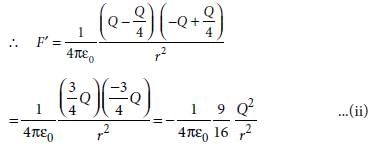
From equations (i) and (ii),



In Case II :


From equations (i) and (ii),

Electric field lines can be said to be - a)lines of equal Electric field
- b)drawing lines of electric fields
- c)lines of equal Electric voltage
- d)graphical representation of electric fields.
Correct answer is option 'D'. Can you explain this answer?
Electric field lines can be said to be
a)
lines of equal Electric field
b)
drawing lines of electric fields
c)
lines of equal Electric voltage
d)
graphical representation of electric fields.
|
|
Abhijeet Menon answered |
Explanation:Electric Field Lines can be defined as a curve which shows direction of electric field, when we draw tangent at its point. The concept of electric field was proposed by Michael Faraday, in the 19th century. He always thought that electric field lines can be used to describe and interpret the invisible electric field. Instead of using complex vector diagram every time, This pictorial representation or form is called electric field lines.Electric field lines can be used to describe electric field around a system of charges in a better way.
A hollow metal sphere of radius R is uniformly charged. The electric field due to the sphere at a distance r from the centre- a)decreases as r increases for r < R and for r > R
- b)increases as r increases for r < R and for r > R
- c)zero as r increases for r < R, decreases as r increases for r > R
- d)zero as r increases for r < R, increases as r increases for r > R
Correct answer is option 'C'. Can you explain this answer?
A hollow metal sphere of radius R is uniformly charged. The electric field due to the sphere at a distance r from the centre
a)
decreases as r increases for r < R and for r > R
b)
increases as r increases for r < R and for r > R
c)
zero as r increases for r < R, decreases as r increases for r > R
d)
zero as r increases for r < R, increases as r increases for r > R

|
Top Rankers answered |
In a uniformly charged hollow conducting sphere


Three point charges +q, –2q and +q are placed at points (x = 0, y = a, z = 0), (x = 0, y = 0, z = 0) and (x = a, y = 0, z = 0) respectively. The magnitude and direction of the electric dipole moment vector of this charge assembly are- a)√2qa along the line joining points (x = 0, y = 0,
z = 0) and (x = a, y = a, z = 0) - b)qa along the line joining points (x = 0, y = 0,
z = 0) and (x = a, y = a, z = 0) - c)√2qa along + x direction
- d)√2qa along + y direction
Correct answer is option 'A'. Can you explain this answer?
Three point charges +q, –2q and +q are placed at points (x = 0, y = a, z = 0), (x = 0, y = 0, z = 0) and (x = a, y = 0, z = 0) respectively. The magnitude and direction of the electric dipole moment vector of this charge assembly are
a)
√2qa along the line joining points (x = 0, y = 0,
z = 0) and (x = a, y = a, z = 0)
z = 0) and (x = a, y = a, z = 0)
b)
qa along the line joining points (x = 0, y = 0,
z = 0) and (x = a, y = a, z = 0)
z = 0) and (x = a, y = a, z = 0)
c)
√2qa along + x direction
d)
√2qa along + y direction

|
Stepway Academy answered |
This consists of two dipoles, –q and +q with dipole moment along with the +y-direction and –q and +q along the x-direction.
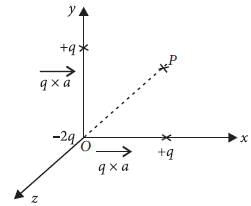

Along the direction 45° that is along OP, where P is (+a, +a, 0).


Along the direction 45° that is along OP, where P is (+a, +a, 0).
Ionization of a neutral atom is the - a)only gain of one or more electrons
- b)only gain of one or more protons
- c)gain or loss of one or more electrons
- d)only gain of one or more neutrons
Correct answer is option 'C'. Can you explain this answer?
Ionization of a neutral atom is the
a)
only gain of one or more electrons
b)
only gain of one or more protons
c)
gain or loss of one or more electrons
d)
only gain of one or more neutrons

|
Ashwin Yadav answered |
Explanation:It is not possible to remove or add protons to atom, but electron can be added or removed by an atom easily so charge can be developed on an atom by removing or adding electrons, by adding electrons it becomes negative charged ,by removing electrons it becomes positive charged.
A point charge Q is moved along a circular path around another fixed point charge The work done is zero - a)only if Q returns to it's starting position
- b)in all cases
- c)only if the two charges have the same magnitude and opposite signs
- d)only if the two charges have the same magnitude
Correct answer is option 'B'. Can you explain this answer?
A point charge Q is moved along a circular path around another fixed point charge The work done is zero
a)
only if Q returns to it's starting position
b)
in all cases
c)
only if the two charges have the same magnitude and opposite signs
d)
only if the two charges have the same magnitude

|
Vaishnavi Dasgupta answered |
Explanation:Since that circular path behave as equipotential surface so work done is always zero.
An electric dipole is placed at an angle of 30° with an electric field intensity 2 x 105 N C–1.It experiences a torque equal to 4 N m. The charge on the dipole, if the dipole length is 2 cm, is- a)8 mC
- b)2 mC
- c)5 mC
- d)7 μC
Correct answer is option 'B'. Can you explain this answer?
An electric dipole is placed at an angle of 30° with an electric field intensity 2 x 105 N C–1.It experiences a torque equal to 4 N m. The charge on the dipole, if the dipole length is 2 cm, is
a)
8 mC
b)
2 mC
c)
5 mC
d)
7 μC

|
Stepway Academy answered |
Here, q = 30°, E = 2 x 105 N C–1, τ = 4 N m,
l = 2 cm = 0.02 m, q = ?
τ = pE sinq = (ql)E sinq
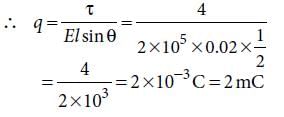
l = 2 cm = 0.02 m, q = ?
τ = pE sinq = (ql)E sinq

A hollow cylinder has a charge q coulomb within it. If f φ is the electric flux in units of volt meter associated with the curved surface B, the flux linked with the plane surface A in units of V-m will be

- a)

- b)

- c)

- d)

Correct answer is option 'D'. Can you explain this answer?
A hollow cylinder has a charge q coulomb within it. If f φ is the electric flux in units of volt meter associated with the curved surface B, the flux linked with the plane surface A in units of V-m will be


a)

b)

c)

d)


|
EduRev NEET answered |
Let φA, φB and φC are the electric flux linked with surface is A, B and C.
According to Gauss theorem,
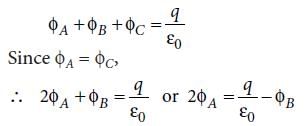

According to Gauss theorem,


A toy car with charge q moves on a frictionless horizontal plane surface under the influence of a uniform electric field  . Due to the force
. Due to the force  , its velocity increases from 0 to 6 m s–1 in one second duration. At that instant the direction of the field is
, its velocity increases from 0 to 6 m s–1 in one second duration. At that instant the direction of the field is
reversed. The car continues to move for two more seconds under the influence of this field. The average velocity and the average speed of the toy car between 0 to 3 seconds are respectively- a)2 m s–1, 4 m s–1
- b)1 m s–1, 3 m s–1
- c)1 m s–1, 3.5 m s–1
- d)1.5 m s–1, 3 m s–1
Correct answer is option 'B'. Can you explain this answer?
A toy car with charge q moves on a frictionless horizontal plane surface under the influence of a uniform electric field  . Due to the force
. Due to the force  , its velocity increases from 0 to 6 m s–1 in one second duration. At that instant the direction of the field is
, its velocity increases from 0 to 6 m s–1 in one second duration. At that instant the direction of the field is
reversed. The car continues to move for two more seconds under the influence of this field. The average velocity and the average speed of the toy car between 0 to 3 seconds are respectively
 . Due to the force
. Due to the force  , its velocity increases from 0 to 6 m s–1 in one second duration. At that instant the direction of the field is
, its velocity increases from 0 to 6 m s–1 in one second duration. At that instant the direction of the field isreversed. The car continues to move for two more seconds under the influence of this field. The average velocity and the average speed of the toy car between 0 to 3 seconds are respectively
a)
2 m s–1, 4 m s–1
b)
1 m s–1, 3 m s–1
c)
1 m s–1, 3.5 m s–1
d)
1.5 m s–1, 3 m s–1

|
Ambition Institute answered |
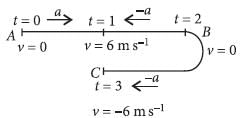
Acceleration 
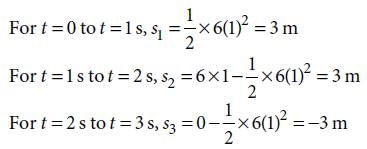






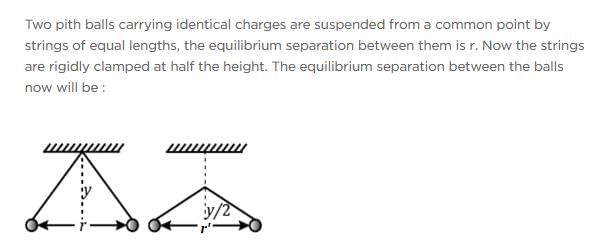
- a)

- b)

- c)

- d)

Correct answer is option 'D'. Can you explain this answer?

a)

b)

c)

d)


|
Ambition Institute answered |
Let m be mass of each ball and q be charge on each ball. Force of repulsion,
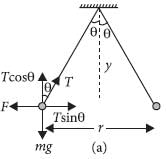

In equilibrium
Tcosq = mg ...(i)
Tsinq = F ...(ii)
Divide (ii) by (i), we get,

From figure (a),

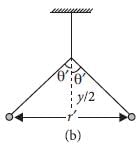

Divide (iv) by (iii), we get



In equilibrium
Tcosq = mg ...(i)
Tsinq = F ...(ii)
Divide (ii) by (i), we get,

From figure (a),



Divide (iv) by (iii), we get

A spherical conductor of radius 10 cm has a charge of 3.2 x 10–7 C distributed uniformly. What is the magnitude of electric field at a point 15 cm from the centre of the sphere?

- a)1.28 x 104 N/C
- b)1.28 x 105 N/C
- c)1.28 x 106 N/C
- d)1.28 x 107 N/C
Correct answer is option 'B'. Can you explain this answer?
A spherical conductor of radius 10 cm has a charge of 3.2 x 10–7 C distributed uniformly. What is the magnitude of electric field at a point 15 cm from the centre of the sphere?


a)
1.28 x 104 N/C
b)
1.28 x 105 N/C
c)
1.28 x 106 N/C
d)
1.28 x 107 N/C

|
Stepway Academy answered |
Here, r = 10 cm, q = 3.2 x 10–7 C


A charge Q is situated at the corner of a cube, the electric flux passed through all the six faces of the cube is- a)

- b)

- c)

- d)

Correct answer is option 'B'. Can you explain this answer?
A charge Q is situated at the corner of a cube, the electric flux passed through all the six faces of the cube is
a)

b)

c)

d)


|
Lead Academy answered |
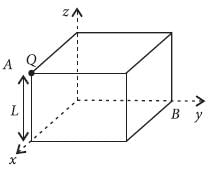
As at a corner, 8 cubes can be placed symmetrically, flux linked with each cube (due to a charge Q at the corner)
will be

Now for the faces passing through the edge A, electric field E at a face will be parallel to area of face and so flux for these three faces will be zero. Now as the cube has six faces and flux linked with three faces (through A) is zero, so flux linked with remaining three faces will be 
Hence, electric flux passed through all the six faces of the cube is

Hence, electric flux passed through all the six faces of the cube is

A long, hollow conducting cylinder is kept coaxially inside another long, hollow conducting cylinder of larger radius. Both the cylinders are initially electrically neutral.- a)No potential difference appears between the two cylinders when same charge density is given to both the cylinders.
- b)No potential difference appears between the two cylinders when a uniform line charge is kept along the axis of the cylinders.
- c)A potential difference appears between the two cylinders when a charge density is given to the outer cylinder.
- d)A potential difference appears between the two cylinders when a charge density is given to the inner cylinder.
Correct answer is option 'D'. Can you explain this answer?
A long, hollow conducting cylinder is kept coaxially inside another long, hollow conducting cylinder of larger radius. Both the cylinders are initially electrically neutral.
a)
No potential difference appears between the two cylinders when same charge density is given to both the cylinders.
b)
No potential difference appears between the two cylinders when a uniform line charge is kept along the axis of the cylinders.
c)
A potential difference appears between the two cylinders when a charge density is given to the outer cylinder.
d)
A potential difference appears between the two cylinders when a charge density is given to the inner cylinder.

|
Juhi Deshpande answered |
Explanation:When the charge is given to inner cylinder than there is an electric field is produced between cylinders which is given by  and due to this a potential difference is developed between two cylinders.
and due to this a potential difference is developed between two cylinders.
A point charge + q is placed at the centre of a cube of side l. The electric flux emerging from the cube is- a)

- b)

- c)zero
- d)

Correct answer is option 'D'. Can you explain this answer?
A point charge + q is placed at the centre of a cube of side l. The electric flux emerging from the cube is
a)

b)

c)
zero
d)


|
Lead Academy answered |
Electric flux emerging from the cube does not depend on size of cube.


A semi-circular arc of radius ' a ' is charged uniformly and the charge per unit length is λ. The electric field at the centre of this arc is- a)

- b)

- c)

- d)

Correct answer is option 'A'. Can you explain this answer?
A semi-circular arc of radius ' a ' is charged uniformly and the charge per unit length is λ. The electric field at the centre of this arc is
a)

b)

c)

d)


|
Lead Academy answered |
λ= linear charge density; Charge on elementary portion dx=λdx.
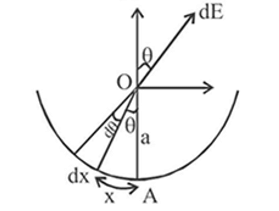
Electric field at
Horizontal electric field, i.e., perpendicular to AO, will be cancelled. Hence, net electric field = addition of all electrical fields in direction of AO =ΣdEcosθ
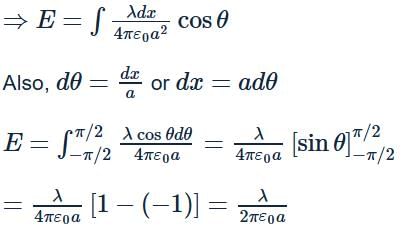

Electric field at

Horizontal electric field, i.e., perpendicular to AO, will be cancelled. Hence, net electric field = addition of all electrical fields in direction of AO =ΣdEcosθ

Positive and negative point charges of equal magnitude are kept at ( 0,0,a/2) and (0,0,-a/2) respectively. The work done by the electric field when another positive point charge is moved from (-a,0,0) to (a,0,0) is
- a)Depends on the path connecting the initial and final positions
- b)Positive
- c)Negative
- d)Zero
Correct answer is option 'D'. Can you explain this answer?
Positive and negative point charges of equal magnitude are kept at ( 0,0,a/2) and (0,0,-a/2) respectively. The work done by the electric field when another positive point charge is moved from (-a,0,0) to (a,0,0) is
a)
Depends on the path connecting the initial and final positions
b)
Positive
c)
Negative
d)
Zero

|
Nisha Banerjee answered |
+Q charge is moving on equatorial line of dipole as shown in figure, since on equatorial line V=0 So W=0
Chapter doubts & questions for Electric Charge - Physics 2025 is part of Grade 9 exam preparation. The chapters have been prepared according to the Grade 9 exam syllabus. The Chapter doubts & questions, notes, tests & MCQs are made for Grade 9 2025 Exam. Find important definitions, questions, notes, meanings, examples, exercises, MCQs and online tests here.
Chapter doubts & questions of Electric Charge - Physics in English & Hindi are available as part of Grade 9 exam.
Download more important topics, notes, lectures and mock test series for Grade 9 Exam by signing up for free.
Physics
307 videos|482 docs|202 tests
|

Contact Support
Our team is online on weekdays between 10 AM - 7 PM
Typical reply within 3 hours
|
Free Exam Preparation
at your Fingertips!
Access Free Study Material - Test Series, Structured Courses, Free Videos & Study Notes and Prepare for Your Exam With Ease

 Join the 10M+ students on EduRev
Join the 10M+ students on EduRev
|

|
Create your account for free
OR
Forgot Password
OR
Signup on EduRev and stay on top of your study goals
10M+ students crushing their study goals daily
